On May 26th, NAEMT hosted a webinar roundtable discussion featuring three distinguished medical directors to discuss how their organizations have been handling triage and transportation decisions during COVID-19, what processes they’ve put in place, and how they hope to continue these practices in the future. Watch the full webinar below, or continue reading for our top seven highlights.
Webinar attendees heard from Stein Bronsky, MD, medical director for Colorado Springs Fire Department and El Paso County AMR; Craig Manifold, DO, medical director for NAEMT; and Ed Racht, MD, chief medical officer from Global Medical Response. NAEMT President Matt Zadavsky acted as moderator. Dr. Racht and his team joined the webinar live from their medical RV at the Bronx Zoo, as part of their FEMA deployment.
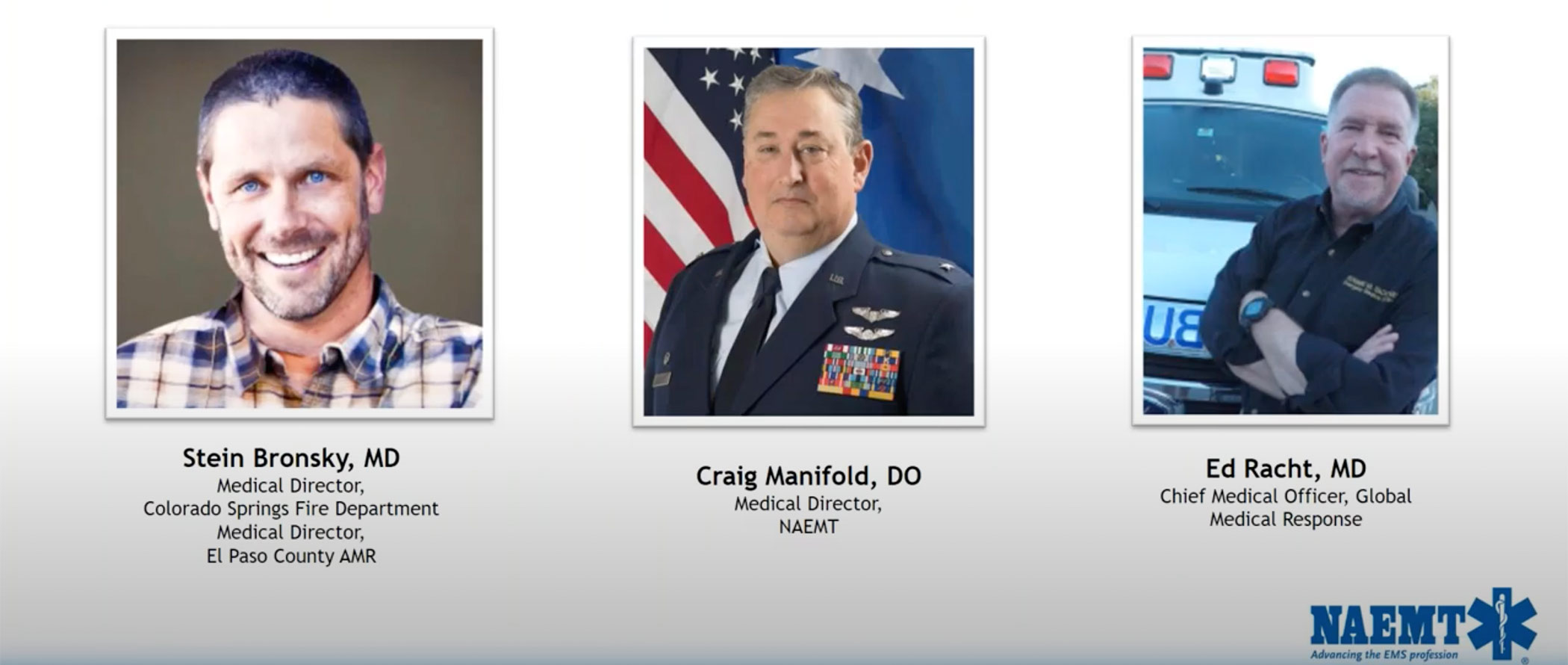
1. COVID-19 has caused many changes to patient hand-off protocols, and Personal Protective Equipment (PPE) has helped keep provider infection rates down.
After COVID-19, some hospitals were hesitant for EMS to enter the emergency department wearing potentially contaminated PPE. This has caused many EMS agencies to adapt to new patient hand-off protocols, such as handing off the patient without entering the building. Colorado Springs has developed a patient hand-off algorithm to determine where each hand-off will occur, based on the patient’s level of risk. San Antonio has transitioned to a community spread model, with lots of variation in hand-off methods and locations. And according to Dr. Racht, New York requires EMS to don PPE for all patient encounters, whether it’s been identified as COVID-19 or not. “This is essentially everything COVID, unless it’s determined not to be,” said Patrick Pickering, the regional director at Global Medical Response. With well over 15,000 transports in 53 days, New York has had extremely high volume and yet maintained a low provider infection rate.
In each location, new hand-off protocols and careful use of PPE have helped keep provider infection rates down.
2. Each of the represented agencies has developed a system for determining when to leave patients in place.
Leave-in-place protocols have helped each department quickly determine whether a patient needs transport to the hospital, or whether they are stable enough to stay home. Dr. Racht explained, “The good news is, the decision to leave-in-place during something like this is a very, very sound clinical decision for the entire system. The practicality of that is what becomes a challenge.” The pandemic has caused New York’s average of 3500-4000 calls a day to increase to an average of 7500. With such extremely high call volume, decisions need to be made on-scene. Often, leaving in place is the most practical choice.
In San Antonio, EMS has used the ETHAN project—in place since December of 2014—which allows a trained medic to screen calls for COVID-19 at dispatch via telemedicine. (Learn more about how EMS agencies are embracing telemedicine here.) That way, they can determine quickly whether the patient will need to be transported or provide them with guidance and additional resources if not. So far, it’s been working for them. “This is an area of impact for our profession that will hopefully continue to be promulgated,” said Dr. Manifold. “We will continue to refine it and use it appropriately because this is an asset that’s not only well-suited for COVID, but for our day-to-day response as well.”
Colorado Springs has adopted similar measures. According to Dr. Bronsky, their crews do a screening process on-scene, even though it’s already been done through the 911 call center. Once on-scene, EMS evaluates the patient based on objective criteria and risk factors. If the patient’s vital signs and physical exam look okay, they may not need to be transported. At that point, they explore other options: telemedicine chief among them. “We are really stressing telemedicine to be set up and initiated right there and then,” said Dr. Bronsky. That way, they can consult with the patient and provide counsel while avoiding potential exposure to COVID-19.
3. Giving medical directors the ability to help in transport decisions is vital.
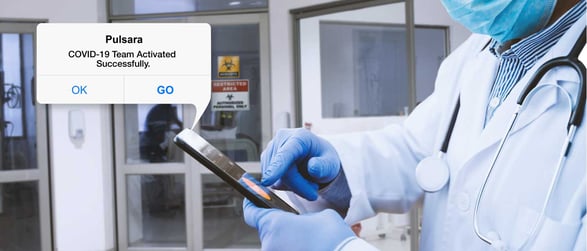
Dr. Manifold explained why the role of the medical director in leave-in-place decisions is highly important: To ensure clinical parameters are being met, and to provide personalized insight into a situation where a screening tool can’t. “That’s where the beauty of having the medical oversight—whether it is a protocol-driven process or the in-person telemedicine component where you can provide additional input or decision-making processes are invaluable. With initiating a program like this, you have to have direct medical director insight, oversight, and the ability to adjust and change as the program matures. We’ve seen that locally depending on the structure of your program,” he said. “The medical director has to find a way to be directly engaged and involved in the development and decision-making.”
4. Telehealth and telemedicine solutions provide EMS with needed flexibility.
"Not every transport decision is clear-cut," Dr. Bronsky said. Though sound protocols help determine whether a patient needs to be seen at the hospital, one of the vital components of making them work is the ability to use telemedicine to connect with the medical direction team.
Colorado Springs uses Pulsara, a telehealth communication platform that connects teams across organizations, to document all patient data in real time and communicate between providers (and, with a new version of the app released at the onset of COVID-19, between providers and patients).
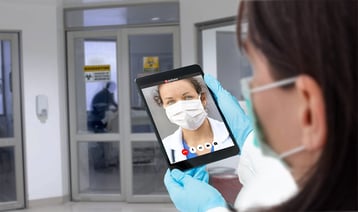 Dr. Bronsky explained how Colorado Springs is leveraging Pulsara to connect first responders with medical directors, helping them make better transport decisions more quickly. “The paramedics can actually ping the medical directors. They put in some basic information about the patient, tell us what’s going on, listen to vital signs, and then we see [the notification] and tap in and talk to them. We can talk to the medic directly, we can see the patient, and we can help evaluate if this patient is a true candidate for the need to be transported. Sometimes we just need to give further explanation to the patients about why we’re not going to be transporting or using our resources. I find that although standing protocols do serve a fundamental, needed base, that the telemedicine capability is extremely valuable in these circumstances to help through the more difficult cases.”
Dr. Bronsky explained how Colorado Springs is leveraging Pulsara to connect first responders with medical directors, helping them make better transport decisions more quickly. “The paramedics can actually ping the medical directors. They put in some basic information about the patient, tell us what’s going on, listen to vital signs, and then we see [the notification] and tap in and talk to them. We can talk to the medic directly, we can see the patient, and we can help evaluate if this patient is a true candidate for the need to be transported. Sometimes we just need to give further explanation to the patients about why we’re not going to be transporting or using our resources. I find that although standing protocols do serve a fundamental, needed base, that the telemedicine capability is extremely valuable in these circumstances to help through the more difficult cases.”
5. Transport protocols for homeless and mental health patients are developing through COVID-19, and could lead to positive changes for the future.
Dr. Manifold and Dr. Racht discussed the challenges of finding more sources of transport and housing for homeless and psychiatric patients during COVID-19. One of the issues COVID-19 forced them to address involved the lack of management of where patients would go. San Antonio decided to implement a regional process to manage the decrease in behavioral health beds, which meant patients could be cleared on-scene by medics, law enforcement, or a traveling psychiatric evaluation team so that the patient can bypass the emergency department and go straight to a predetermined behavioral health facility. Though it’s taken a fair amount of work, they’ve found ways to manage a situation that was a challenge long before COVID-19.
Colorado Springs has developed an emergent psychiatric response team (CRT) to help streamline the process for admitting psychiatric patients. The CRT consists of a paramedic, law enforcement officer, and a licensed clinical social worker. The team is able to evaluate the patient in the field and determine the necessary course of action. The social worker has the authority to clear the patient to be left on-scene, or decide that the patient needs admission or involuntary hold. The social worker can work with the behavioral health organization to accept a direct admit right from the field, so there’s no need for ambulance transport. The paramedic then conducts a screening, consisting of questions and a physical exam. If the patient needs to go to a facility, the medic can run them through the psychiatric facility admission exclusion criteria from the field and transport the patient from there. By removing the bureaucratic roadblocks, Colorado Springs has been able to condense a multi-day process into an hour and a half.
6. After COVID-19, mobile integrated health and community paramedicine will only expand.
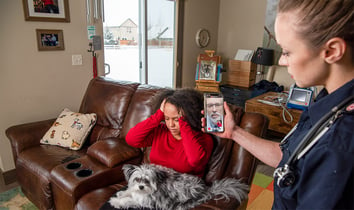 All three presenters emphasized that mobile integrated health and community paramedicine will not be the same after COVID-19, as the expanded role and capabilities of EMS during this crisis will make it difficult, if not impossible, to return to how things were before the pandemic. Zavadsky told a recent story to underscore the point. “We had the opportunity to be on a phone call recently with CMS—the medicare part of CMS—and one of the comments that was made by the CMS staffers was that it’s gonna be hard for them to put the genie back in the bottle. What they meant was that a lot of the policies and changes and payment policy changes they’ve made in the last month or two are proving to be relatively successful, and it’s gonna be hard to undo those. They were specifically referring to telemedicine and the relaxation of some of those rules. We thought of it as: you don’t even know the half of what you just said, because now, communities across the country have come to learn that EMS can do things differently if they’re empowered to do so, and out of need for partnering with the healthcare system. And now they’re coming to expect different things from us. We can’t put this genie back in the bottle, either. So how are we going to sustain ourselves, given this new role that we’re going to have? That will be very interesting to see.”
All three presenters emphasized that mobile integrated health and community paramedicine will not be the same after COVID-19, as the expanded role and capabilities of EMS during this crisis will make it difficult, if not impossible, to return to how things were before the pandemic. Zavadsky told a recent story to underscore the point. “We had the opportunity to be on a phone call recently with CMS—the medicare part of CMS—and one of the comments that was made by the CMS staffers was that it’s gonna be hard for them to put the genie back in the bottle. What they meant was that a lot of the policies and changes and payment policy changes they’ve made in the last month or two are proving to be relatively successful, and it’s gonna be hard to undo those. They were specifically referring to telemedicine and the relaxation of some of those rules. We thought of it as: you don’t even know the half of what you just said, because now, communities across the country have come to learn that EMS can do things differently if they’re empowered to do so, and out of need for partnering with the healthcare system. And now they’re coming to expect different things from us. We can’t put this genie back in the bottle, either. So how are we going to sustain ourselves, given this new role that we’re going to have? That will be very interesting to see.”
7. Looking forward, there are plenty of applications—and hope—for the future.
Dr. Zavadsky concluded the webinar by asking each of the panelists how the lessons they are learning will help prepare for the future. Though they each approached the question from a different angle, they all agreed that EMS (as we knew it before COVID) will never be the same. Dr. Racht pointed out the coming hurricane and wildfire seasons and the potential for facing large numbers of patients and providers that have to be housed. “The lessons we are learning and continue to learn in COVID will be with us for a long time,” he said. “This changed us. We will be different. How we use this in large-scale environments is our next evolving challenge. That will be a challenge we will face in the not-too-distant future.” Dr. Bronsky agreed. “This will completely change the way that we do a lot of things. There will be a residual baseline of effects of this COVID era on us in the way that we organize into the future. I believe we should all be talking about it because we know that we’re going to be dealing with it.”
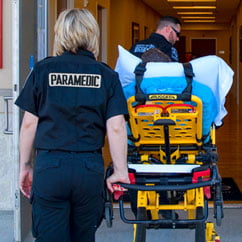
Dr. Manifold had the final word of encouragement, reminding everyone that though navigating the future will be challenging, this is exactly the sort of situation EMS is suited for:
“Ladies and gentlemen, this is what we do. This is part of our EMS profession. It’s part of our disaster response matrix. It’s what we are trained to respond to. As we know with a lot of these things in disaster management, from the patient or individual component, it’s about the logistics, maintaining the sanitation, disinfection, social distancing, transportation pieces that come with that, and applying the challenges. . . . It’s in our blood and it’s what we do—and we do it well. Let’s learn the lessons, apply them for our future needs, and we’ll be in great shape.”
To learn more about how Pulsara can streamline communication for your team, visit us at Pulsara.com.
 Team Pulsara
Team Pulsara
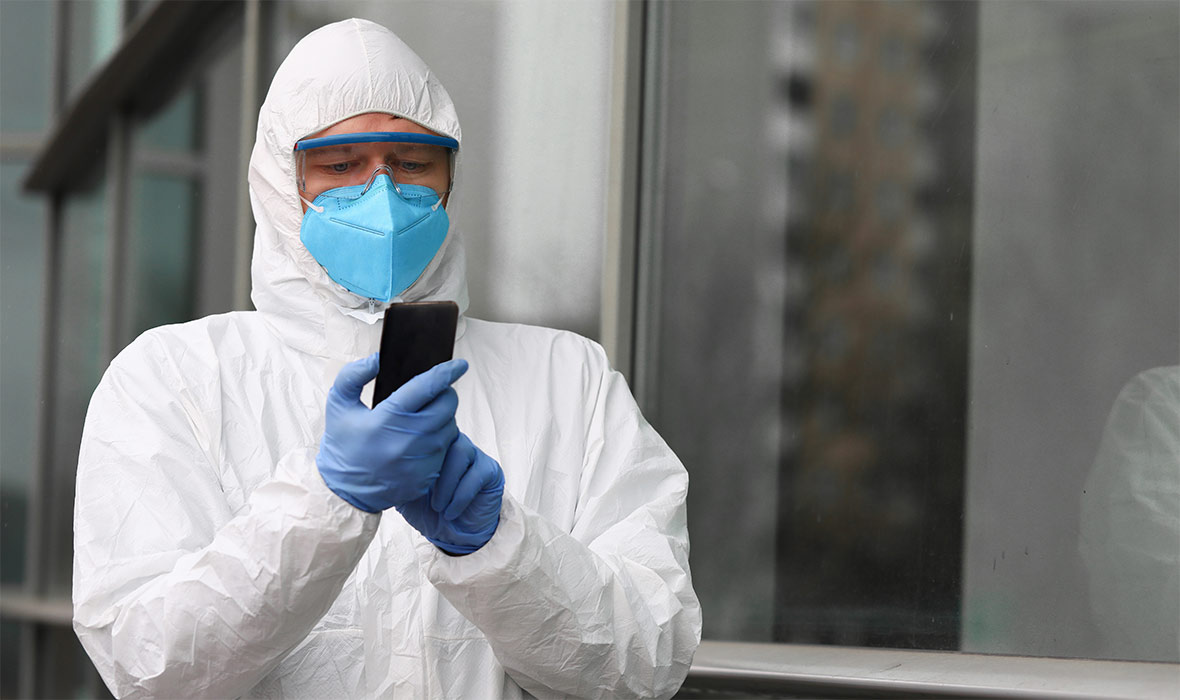


 Dr. Bronsky explained how Colorado Springs is leveraging Pulsara to connect first responders with medical directors, helping them make better transport decisions more quickly. “The paramedics can actually ping the medical directors. They put in some basic information about the patient, tell us what’s going on, listen to vital signs, and then we see [the notification] and tap in and talk to them. We can talk to the medic directly, we can see the patient, and we can help evaluate if this patient is a true candidate for the need to be transported. Sometimes we just need to give further explanation to the patients about why we’re not going to be transporting or using our resources. I find that although standing protocols do serve a fundamental, needed base, that the telemedicine capability is extremely valuable in these circumstances to help through the more difficult cases.”
Dr. Bronsky explained how Colorado Springs is leveraging Pulsara to connect first responders with medical directors, helping them make better transport decisions more quickly. “The paramedics can actually ping the medical directors. They put in some basic information about the patient, tell us what’s going on, listen to vital signs, and then we see [the notification] and tap in and talk to them. We can talk to the medic directly, we can see the patient, and we can help evaluate if this patient is a true candidate for the need to be transported. Sometimes we just need to give further explanation to the patients about why we’re not going to be transporting or using our resources. I find that although standing protocols do serve a fundamental, needed base, that the telemedicine capability is extremely valuable in these circumstances to help through the more difficult cases.” All three presenters emphasized that mobile integrated health and community paramedicine will not be the same after COVID-19, as the expanded role and capabilities of EMS during this crisis will make it difficult, if not impossible, to return to how things were before the pandemic. Zavadsky told a recent story to underscore the point. “We had the opportunity to be on a phone call recently with CMS—the medicare part of CMS—and one of the comments that was made by the CMS staffers was that it’s gonna be hard for them to put the genie back in the bottle. What they meant was that a lot of the policies and changes and payment policy changes they’ve made in the last month or two are proving to be relatively successful, and it’s gonna be hard to undo those. They were specifically referring to telemedicine and the relaxation of some of those rules. We thought of it as: you don’t even know the half of what you just said, because now, communities across the country have come to learn that EMS can do things differently if they’re empowered to do so, and out of need for partnering with the healthcare system. And now they’re coming to expect different things from us. We can’t put this genie back in the bottle, either. So how are we going to sustain ourselves, given this new role that we’re going to have? That will be very interesting to see.”
All three presenters emphasized that mobile integrated health and community paramedicine will not be the same after COVID-19, as the expanded role and capabilities of EMS during this crisis will make it difficult, if not impossible, to return to how things were before the pandemic. Zavadsky told a recent story to underscore the point. “We had the opportunity to be on a phone call recently with CMS—the medicare part of CMS—and one of the comments that was made by the CMS staffers was that it’s gonna be hard for them to put the genie back in the bottle. What they meant was that a lot of the policies and changes and payment policy changes they’ve made in the last month or two are proving to be relatively successful, and it’s gonna be hard to undo those. They were specifically referring to telemedicine and the relaxation of some of those rules. We thought of it as: you don’t even know the half of what you just said, because now, communities across the country have come to learn that EMS can do things differently if they’re empowered to do so, and out of need for partnering with the healthcare system. And now they’re coming to expect different things from us. We can’t put this genie back in the bottle, either. So how are we going to sustain ourselves, given this new role that we’re going to have? That will be very interesting to see.”
![[PRESS RELEASE] Published Research Finds Up to 31% Faster STEMI Treatment Times in Rural Hospital Setting with Pulsara](https://www.pulsara.com/hubfs/_1_website-page-blog-assets/pulsara-hosp-teams-assign-cardio-stemi-rn-1200x701.jpg)

